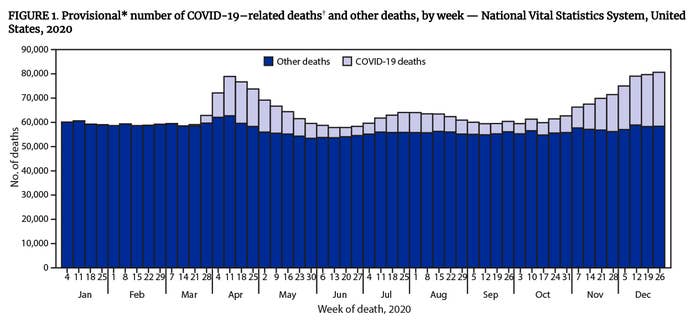
Rebuking claims of inflated COVID-19 death estimates, the CDC confirmed death certificates showing that the coronavirus killed more than 375,000 Americans in 2020.
COVID-19 became the third leading cause of death nationwide, after heart disease and cancer, the reports released on Wednesday found. Nearly 3.6 million Americans died overall in 2020, with COVID-19 driving a 15.9% increase in the nationwide death rate, alongside increases from heart disease, injuries, Alzheimer's, and diabetes.
“Some of those ‘excess deaths’ are from COVID-19 and weren’t reported,” CDC National Center for Health Statistics mortality statistics chief Robert Anderson told BuzzFeed News. In the CDC’s Morbidity and Mortality Report analysis, his team found that while 5.5% of COVID-19 death certificates listed the disease as the sole cause of death, 97% of the others had died of other causes that COVID-19 made fatal.
Based on the health agency’s analysis, the reported number of people who died of COVID-19 is most likely an underestimate. “Our findings suggest that death certificates more provide a ‘floor’ for COVID-19 deaths,” said Anderson.
In the last 13 months, COVID-19 has killed over 550,000 Americans, with many following a post–holiday season surge. While deaths have been steadily declining since then, concerns about a possible fourth surge have led some public health officials to fear another rise in deaths.
The agency’s new report was intended to address persistent concerns from some critics who have claimed that COVID-19 deaths have been overcounted. Both before and after the election, former president Donald Trump repeatedly claimed that doctors were overcounting COVID-19 deaths for financial gain, with others claiming mortality rates from the disease were exaggerated.
"There was some misunderstanding out there that we should only count COVID-19 deaths where that was the only cause listed on a death certificate. But that's not how death certificates work," said Anderson. "This report was in part intended to answer that concern."

The US has a patchwork of state and county laws governing how physicians, coroners, and medical examiners fill out death certificates. Such reports are intended to demonstrate a chain of mechanisms that cause deaths, for example, a patient with hepatitis dying of resulting liver failure.
Anderson suggested that an increase in excess deaths from April last year, early in the pandemic, likely points to unreported COVID-19 deaths that make death certificate figures over the course of the pandemic an undercount. “In particular, we saw increases in deaths from pneumonia alone that just point to the disease being unrecognized,” Anderson said.
“It’s a nice analysis, and it is good to see CDC steering things in the right direction,” said Georgia State University public health expert Gerardo Chowell-Puente, noting the agency was criticized last year for low-balling coronavirus fatality rates.
Numbers of U.S. uncategorized deaths last year weren't so high as to make the CDC's death certificate estimate of COVID-19 mortality a gross undercount, said medical demographer Andrew Noymer of the University of California, Irvine. There just aren't that many "excess" deaths for the year in medical records to leave much room for COVID-19 mortality numbers to be much higher, at least in the US.
"This is a 'floor', but the ceiling isn't a lot higher," said Noymer.
At a White House briefing on Wednesday, CDC Director Rochelle Walensky noted that the death figures also reconfirmed that COVID-19 has disproportionately harmed people of color in the US. Among Native American, Hispanic, and Black patients, she said, COVID-19 death rates were more than double those of white ones.
“Sadly, based on the current state of the pandemic, these impacts have remained in 2021, where we continue to see that communities of color account for an outsize portion of these deaths,” Walensky said.
UPDATE
This post has been updated with comment from Andrew Noymer of the University of California, Irvine
